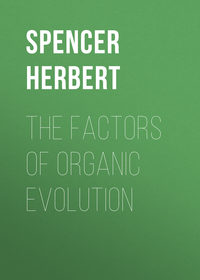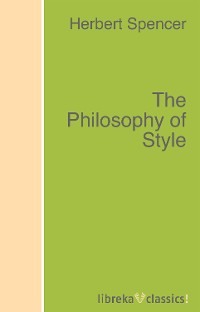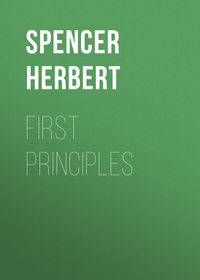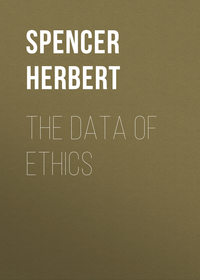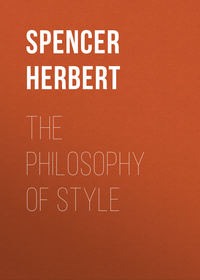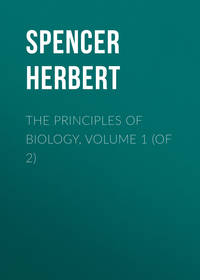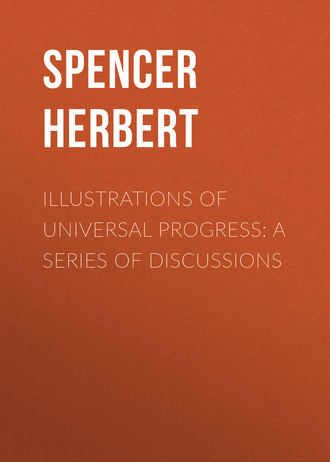 полная версия
полная версияIllustrations of Universal Progress: A Series of Discussions
Meanwhile, physics had been carrying further that progress without which, as just shown, rational mechanics could not be disentangled. In hydrostatics, Stevinus had extended and applied the discovery of Archimedes. Torricelli had proved atmospheric pressure, "by showing that this pressure sustained different liquids at heights inversely proportional to their densities;" and Pascal "established the necessary diminution of this pressure at increasing heights in the atmosphere: " discoveries which in part reduced this branch of science to a quantitative form. Something had been done by Daniel Bernoulli towards the dynamics of fluids. The thermometer had been invented; and a number of small generalizations reached by it. Huyghens and Newton had made considerable progress in optics; Newton had approximately calculated the rate of transmission of sound; and the continental mathematicians had succeeded in determining some of the laws of sonorous vibrations. Magnetism and electricity had been considerably advanced by Gilbert. Chemistry had got as far as the mutual neutralization of acids and alkalies. And Leonardo da Vinci had advanced in geology to the conception of the deposition of marine strata as the origin of fossils. Our present purpose does not require that we should give particulars. All that it here concerns us to do is to illustrate the consensus subsisting in this stage of growth, and afterwards. Let as look at a few cases.
The theoretic law of the velocity of sound enunciated by Newton on purely mechanical considerations, was found wrong by one-sixth. The error remained unaccounted for until the time of Laplace, who, suspecting that the heat disengaged by the compression of the undulating strata of the air, gave additional elasticity, and so produced the difference, made the needful calculations and found he was right. Thus acoustics was arrested until thermology overtook and aided it. When Boyle and Marriot had discovered the relation between the density of gases and the pressures they are subject to; and when it thus became possible to calculate the rate of decreasing density in the upper parts of the atmosphere; it also became possible to make approximate tables of the atmospheric refraction of light. Thus optics, and with it astronomy, advanced with barology. After the discovery of atmospheric pressure had led to the invention of the air-pump by Otto Guericke; and after it had become known that evaporation increases in rapidity as atmospheric pressure decreases; it became possible for Leslie, by evaporation in a vacuum, to produce the greatest cold known; and so to extend our knowledge of thermology by showing that there is no zero within reach of our researches. When Fourier had determined the laws of conduction of heat, and when the Earth's temperature had been found to increase below the surface one degree in every forty yards, there were data for inferring the past condition of our globe; the vast period it has taken to cool down to its present state; and the immense age of the solar system – a purely astronomical consideration.
Chemistry having advanced sufficiently to supply the needful materials, and a physiological experiment having furnished the requisite hint, there came the discovery of galvanic electricity. Galvanism reacting on chemistry disclosed the metallic bases of the alkalies, and inaugurated the electro-chemical theory; in the hands of Oersted and Ampère it led to the laws of magnetic action; and by its aid Faraday has detected significant facts relative to the constitution of light. Brewster's discoveries respecting double refraction and dipolarization proved the essential truth of the classification of crystalline forms according to the number of axes, by showing that the molecular constitution depends upon the axes. In these and in numerous other cases, the mutual influence of the sciences has been quite independent of any supposed hierarchical order. Often, too, their inter-actions are more complex than as thus instanced – involve more sciences than two. One illustration of this must suffice. We quote it in full from the History of the Inductive Sciences. In Book XI., chap. II., on "The Progress of the Electrical Theory," Dr. Whewell writes: —
"Thus at that period, mathematics was behind experiment, and a problem was proposed, in which theoretical results were wanted for comparison with observation, but could not be accurately obtained; as was the case in astronomy also, till the time of the approximate solution of the problem of three bodies, and the consequent formation of the tables of the moon and planets, on the theory of universal gravitation. After some time, electrical theory was relieved from this reproach, mainly in consequence of the progress which astronomy had occasioned in pure mathematics. About 1801 there appeared in the Bulletin des Sciences, an exact solution of the problem of the distribution of electric fluid on a spheroid, obtained by Biot, by the application of the peculiar methods which Laplace had invented for the problem of the figure of the planets. And, in 1811, M. Poisson applied Laplace's artifices to the case of two spheres acting upon one another in contact, a case to which many of Coulomb's experiments were referrible; and the agreement of the results of theory and observation, thus extricated from Coulomb's numbers obtained above forty years previously, was very striking and convincing."
Not only do the sciences affect each other after this direct manner, but they affect each other indirectly. Where there is no dependence, there is yet analogy —equality of relations; and the discovery of the relations subsisting among one set of phenomena, constantly suggests a search for the same relations among another set. Thus the established fact that the force of gravitation varies inversely as the square of the distance, being recognized as a necessary characteristic of all influences proceeding from a centre, raised the suspicion that heat and light follow the same law; which proved to be the case – a suspicion and a confirmation which were repeated in respect to the electric and magnetic forces. Thus again the discovery of the polarization of light led to experiments which ended in the discovery of the polarization of heat – a discovery that could never have been made without the antecedent one. Thus, too, the known refrangibility of light and heat lately produced the inquiry whether sound also is not refrangible; which on trial it turns out to be.
In some cases, indeed, it is only by the aid of conceptions derived from one class of phenomena that hypotheses respecting other classes can be formed. The theory, at one time favoured, that evaporation is a solution of water in air, was an assumption that the relation between water and air is like the relation between salt and water; and could never have been conceived if the relation between salt and water had not been previously known. Similarly the received theory of evaporation – that it is a diffusion of the particles of the evaporating fluid in virtue of their atomic repulsion – could not have been entertained without a foregoing experience of magnetic and electric repulsions. So complete in recent days has become this consensus among the sciences, caused either by the natural entanglement of their phenomena, or by analogies in the relations of their phenomena, that scarcely any considerable discovery concerning one order of facts now takes place, without very shortly leading to discoveries concerning other orders.
To produce a tolerably complete conception of this process of scientific evolution, it would be needful to go back to the beginning, and trace in detail the growth of classifications and nomenclatures; and to show how, as subsidiary to science, they have acted upon it, and it has reacted upon them. We can only now remark that, on the one hand, classifications and nomenclatures have aided science by continually subdividing the subject-matter of research, and giving fixity and diffusion to the truths disclosed; and that on the other hand, they have caught from it that increasing quantitativeness, and that progress from considerations touching single phenomena to considerations touching the relations among many phenomena, which we have been describing.
Of this last influence a few illustrations must be given. In chemistry it is seen in the facts, that the dividing of matter into the four elements was ostensibly based upon the single property of weight; that the first truly chemical division into acid and alkaline bodies, grouped together bodies which had not simply one property in common, but in which one property was constantly related to many others; and that the classification now current, places together in groups supporters of combustion, metallic and non-metallic bases, acids, salts, &c., bodies which are often quite unlike in sensible qualities, but which are like in the majority of their relations to other bodies. In mineralogy again, the first classifications were based upon differences in aspect, texture, and other physical attributes. Berzelius made two attempts at a classification based solely on chemical constitution. That now current, recognises as far as possible the relations between physical and chemical characters. In botany the earliest classes formed were trees, shrubs, and herbs: magnitude being the basis of distinction. Dioscorides divided vegetables into aromatic, alimentary, medicinal, and vinous: a division of chemical character. Cæsalpinus classified them by the seeds, and seed-vessels, which he preferred because of the relations found to subsist between the character of the fructification and the general character of the other parts.
While the "natural system" since developed, carrying out the doctrine of Linnæus, that "natural orders must be formed by attention not to one or two, but to all the parts of plants," bases its divisions on like peculiarities which are found to be constantly related to the greatest number of other like peculiarities. And similarly in zoology, the successive classifications, from having been originally determined by external and often subordinate characters not indicative of the essential nature, have been gradually more and more determined by those internal and fundamental differences, which have uniform relations to the greatest number of other differences. Nor shall we be surprised at this analogy between the modes of progress of positive science and classification, when we bear in mind that both proceed by making generalizations; that both enable us to make previsions differing only in their precision; and that while the one deals with equal properties and relations, the other deals with properties and relations that approximate towards equality in variable degrees.
Without further argument, it will, we think, be sufficiently clear that the sciences are none of them separately evolved – are none of them independent either logically or historically; but that all of them have, in a greater or less degree, required aid and reciprocated it. Indeed, it needs but to throw aside theses, and contemplate the mixed character of surrounding phenomena, to at once see that these notions of division and succession in the kinds of knowledge are none of them actually true, but are simple scientific fictions: good, if regarded merely as aids to study; bad, if regarded as representing realities in Nature. Consider them critically, and no facts whatever are presented to our senses uncombined with other facts – no facts whatever but are in some degree disguised by accompanying facts: disguised in such a manner that all must be partially understood before any one can be understood. If it be said, as by M. Comte, that gravitating force should be treated of before other forces, seeing that all things are subject to it, it may on like grounds be said that heat should be first dealt with; seeing that thermal forces are everywhere in action; that the ability of any portion of matter to manifest visible gravitative phenomena depends on its state of aggregation, which is determined by heat; that only by the aid of thermology can we explain those apparent exceptions to the gravitating tendency which are presented by steam and smoke, and so establish its universality, and that, indeed, the very existence of the solar system in a solid form is just as much a question of heat as it is one of gravitation.
Take other cases: – All phenomena recognised by the eyes, through which only are the data of exact science ascertainable, are complicated with optical phenomena; and cannot be exhaustively known until optical principles are known. The burning of a candle cannot be explained without involving chemistry, mechanics, thermology. Every wind that blows is determined by influences partly solar, partly lunar, partly hygrometric; and implies considerations of fluid equilibrium and physical geography. The direction, dip, and variations of the magnetic needle, are facts half terrestrial, half celestial – are caused by earthly forces which have cycles of change corresponding with astronomical periods. The flowing of the gulf-stream and the annual migration of icebergs towards the equator, depending as they do on the balancing of the centripetal and centrifugal forces acting on the ocean, involve in their explanation the Earth's rotation and spheroidal form, the laws of hydrostatics, the relative densities of cold and warm water, and the doctrines of evaporation. It is no doubt true, as M. Comte says, that "our position in the solar system, and the motions, form, size, equilibrium of the mass of our world among the planets, must be known before we can understand the phenomena going on at its surface." But, fatally for his hypothesis, it is also true that we must understand a great part of the phenomena going on at its surface before we can know its position, &c., in the solar system. It is not simply that, as we have already shown, those geometrical and mechanical principles by which celestial appearances are explained, were first generalized from terrestrial experiences; but it is that the very obtainment of correct data, on which to base astronomical generalizations, implies advanced terrestrial physics.
Until after optics had made considerable advance, the Copernican system remained but a speculation. A single modern observation on a star has to undergo a careful analysis by the combined aid of various sciences – has to be digested by the organism of the sciences; which have severally to assimilate their respective parts of the observation, before the essential fact it contains is available for the further development of astronomy. It has to be corrected not only for nutation of the earth's axis and for precession of the equinoxes, but for aberration and for refraction; and the formation of the tables by which refraction is calculated, presupposes knowledge of the law of decreasing density in the upper atmospheric strata; of the law of decreasing temperature, and the influence of this on the density; and of hygrometric laws as also affecting density. So that, to get materials for further advance, astronomy requires not only the indirect aid of the sciences which have presided over the making of its improved instruments, but the direct aid of an advanced optics, of barology, of thermology, of hygrometry; and if we remember that these delicate observations are in some cases registered electrically, and that they are further corrected for the "personal equation" – the time elapsing between seeing and registering, which varies with different observers – we may even add electricity and psychology. If, then, so apparently simple a thing as ascertaining the position of a star is complicated with so many phenomena, it is clear that this notion of the independence of the sciences, or certain of them, will not hold.
Whether objectively independent or not, they cannot be subjectively so – they cannot have independence as presented to our consciousness; and this is the only kind of independence with which we are concerned. And here, before leaving these illustrations, and especially this last one, let us not omit to notice how clearly they exhibit that increasingly active consensus of the sciences which characterizes their advancing development. Besides finding that in these later times a discovery in one science commonly causes progress in others; besides finding that a great part of the questions with which modern science deals are so mixed as to require the co-operation of many sciences for their solution; we find in this last case that, to make a single good observation in the purest of the natural sciences, requires the combined assistance of half a dozen other sciences.
Perhaps the clearest comprehension of the interconnected growth of the sciences may be obtained by contemplating that of the arts, to which it is strictly analogous, and with which it is inseparably bound up. Most intelligent persons must have been, at one time or other, struck with the vast array of antecedents pre-supposed by one of our processes of manufacture. Let him trace the production of a printed cotton, and consider all that is implied by it. There are the many successive improvements through which the power-looms reached their present perfection; there is the steam-engine that drives them, having its long history from Papin downwards; there are the lathes in which its cylinder was bored, and the string of ancestral lathes from which those lathes proceeded; there is the steam-hammer under which its crank shaft was welded; there are the puddling-furnaces, the blast-furnaces, the coal-mines and the iron-mines needful for producing the raw material; there are the slowly improved appliances by which the factory was built, and lighted, and ventilated; there are the printing engine, and the die house, and the colour laboratory with its stock of materials from all parts of the world, implying cochineal-culture, logwood-cutting, indigo-growing; there are the implements used by the producers of cotton, the gins by which it is cleaned, the elaborate machines by which it is spun: there are the vessels in which cotton is imported, with the building-slips, the rope-yards, the sail-cloth factories, the anchor-forges, needful for making them; and besides all these directly necessary antecedents, each of them involving many others, there are the institutions which have developed the requisite intelligence, the printing and publishing arrangements which have spread the necessary information, the social organization which has rendered possible such a complex co-operation of agencies.
Further analysis would show that the many arts thus concerned in the economical production of a child's frock, have each of them been brought to its present efficiency by slow steps which the other arts have aided; and that from the beginning this reciprocity has been ever on the increase. It needs but on the one hand to consider how utterly impossible it is for the savage, even with ore and coal ready, to produce so simple a thing as an iron hatchet; and then to consider, on the other hand, that it would have been impracticable among ourselves, even a century ago, to raise the tubes of the Britannia bridge from lack of the hydraulic press; to at once see how mutually dependent are the arts, and how all must advance that each may advance. Well, the sciences are involved with each other in just the same manner. They are, in fact, inextricably woven into this same complex web of the arts; and are only conventionally independent of it. Originally the two were one. How to fix the religious festivals; when to sow; how to weigh commodities; and in what manner to measure ground; were the purely practical questions out of which arose astronomy, mechanics, geometry. Since then there has been a perpetual inosculation of the sciences and the arts. Science has been supplying art with truer generalizations and more completely quantitative previsions. Art has been supplying science with better materials, and more perfect instruments. And all along the interdependence has been growing closer, not only between art and science, but among the arts themselves, and among the sciences themselves.
How completely the analogy holds throughout, becomes yet clearer when we recognise the fact that the sciences are arts to each other. If, as occurs in almost every case, the fact to be analyzed by any science, has first to be prepared – to be disentangled from disturbing facts by the afore discovered methods of other sciences; the other sciences so used, stand in the position of arts. If, in solving a dynamical problem, a parallelogram is drawn, of which the sides and diagonal represent forces, and by putting magnitudes of extension for magnitudes of force a measurable relation is established between quantities not else to be dealt with; it may be fairly said that geometry plays towards mechanics much the same part that the fire of the founder plays towards the metal he is going to cast. If, in analyzing the phenomena of the coloured rings surrounding the point of contact between two lenses, a Newton ascertains by calculation the amount of certain interposed spaces, far too minute for actual measurement; he employs the science of number for essentially the same purpose as that for which the watchmaker employs tools. If, before writing down his observation on a star, the astronomer has to separate from it all the errors resulting from atmospheric and optical laws, it is manifest that the refraction-tables, and logarithm-books, and formulæ, which he successively uses, serve him much as retorts, and filters, and cupels serve the assayer who wishes to separate the pure gold from all accompanying ingredients.
So close, indeed, is the relationship, that it is impossible to say where science begins and art ends. All the instruments of the natural philosopher are the products of art; the adjusting one of them for use is an art; there is art in making an observation with one of them; it requires art properly to treat the facts ascertained; nay, even the employing established generalizations to open the way to new generalizations, may be considered as art. In each of these cases previously organized knowledge becomes the implement by which new knowledge is got at: and whether that previously organized knowledge is embodied in a tangible apparatus or in a formula, matters not in so far as its essential relation to the new knowledge is concerned. If, as no one will deny, art is applied knowledge, then such portion of a scientific investigation as consists of applied knowledge is art. So that we may even say that as soon as any prevision in science passes out of its originally passive state, and is employed for reaching other previsions, it passes from theory into practice – becomes science in action – becomes art. And when we thus see how purely conventional is the ordinary distinction, how impossible it is to make any real separation – when we see not only that science and art were originally one; that the arts have perpetually assisted each other; that there has been a constant reciprocation of aid between the sciences and arts; but that the sciences act as arts to each other, and that the established part of each science becomes an art to the growing part – when we recognize the closeness of these associations, we shall the more clearly perceive that as the connexion of the arts with each other has been ever becoming more intimate; as the help given by sciences to arts and by arts to sciences, has been age by age increasing; so the interdependence of the sciences themselves has been ever growing greater, their mutual relations more involved, their consensus more active.
In here ending our sketch of the Genesis of Science, we are conscious of having done the subject but scant justice. Two difficulties have stood in our way: one, the having to touch on so many points in such small space; the other, the necessity of treating in serial arrangement a process which is not serial – a difficulty which must ever attend all attempts to delineate processes of development, whatever their special nature. Add to which, that to present in anything like completeness and proportion, even the outlines of so vast and complex a history, demands years of study. Nevertheless, we believe that the evidence which has been assigned suffices to substantiate the leading propositions with which we set out. Inquiry into the first stages of science confirms the conclusion which we drew from the analysis of science as now existing, that it is not distinct from common knowledge, but an outgrowth from it – an extension of the perception by means of the reason.



